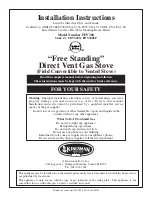
INSTALLATION AND OPERATION
Gas inlet is located on the back of the unit.
INSTALLATION REGULATIONS
This gas appliance must be installed by a qualified installer in accordance with local building codes, or in the absence
of local codes, with the current CAN\CGA-B149.1 or .2 Installation Code (in Canada) or the current National Fuel
Gas Code Z223.1 when installed in the United States.
This appliance, when installed, must be electrically connected and grounded in accordance with local codes, with the
current CSA C22.2 Canadian Electrical Code or with the national Electrical Code; ANSI/NFPA 70-1987 when
installed in the United States.
This unit is certified for installation in a bedroom or bed sitting room, the unit must be installed with listed thermostat.
IN CANADA
these units are acceptable for mobile homes (manufactured) home installations
after first sale
.
Though it would be very beneficial to also check with your local building codes, in respect to each province, or
jurisdiction.
Efficiency rating of the appliance is a product thermal efficiency
rating determined under continuous operating and was determined
independently of any installed system.
CAUTION: Label all wires prior to disconnection when
servicing controls. Wiring errors can cause improper and
dangerous operation.
Verify proper operation after servicing.
FOR SAFE INSTALLATION AND OPERATION OF YOUR
GAS STOVE PLEASE NOTE THE FOLLOWING:
1. This appliance gives off high temperatures and should be located out of heavy traffic areas and away from
furniture and draperies.
2. Children and adults should be alerted to the hazards of the high surface temperatures of this appliance and
should stay away to avoid burns or ignition of clothing.
3. Children should be carefully supervised when they are in the same room as your fireplace appliance.
4. Under no circumstances should this appliance be modified. Any parts that have to be removed for servicing
should be replaced prior to operating this appliance.
5. Installation and any repairs should be done by a qualified service person. The appliance should be inspected
before use and at least annually by a professional service person. More frequent cleaning may be required
due to excessive lint from carpeting, bedding material, etcetera. It is imperative that control compartments,
burners and circulating air passageways of the appliance be kept clean.
6. Periodically remove the logs from the grate assembly and vacuum any loose particles from the grate and
burner area.
5
A
28.750
B
28.250
C
19.750
D
18.250
E
4” Dia.
F
4.75
G
7” Dia.
Vertical Venting in Cold Climates
In cold climate conditions where temperatures go below -10 degrees
Celsius or 14 degrees Fahrenheit, we recommend that the chase be
insulated and where the vent pipe enters into the attic space that the pipe
be wrapped with an insulated mylar sleeve. This will increase the
temperature of the vent and help the appliance to vent properly in cold
weather conditions.
It is also important in vertical vented direct vent appliances that the
appliance be operated daily during the winter months as this will help stop
the Termination from freezing up. We recommend using a thermostat set at
NOTE: It is recommended that a Carbon Monoxide (CO) Detector be installed in or near bedrooms and on all
levels of your home. Place a detector about 15 feet (4.5 meters) outside the room that houses your gas appliance.






































